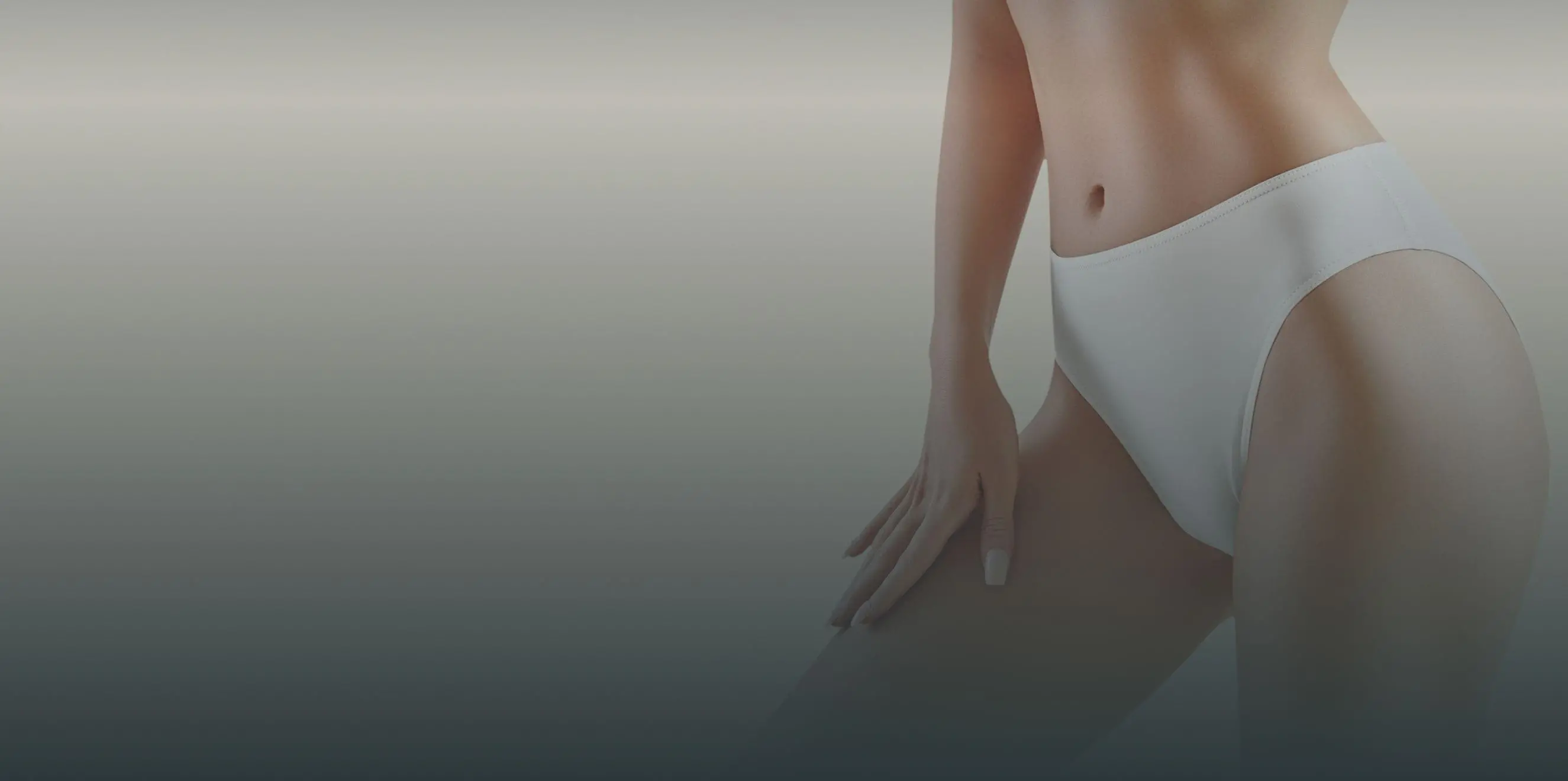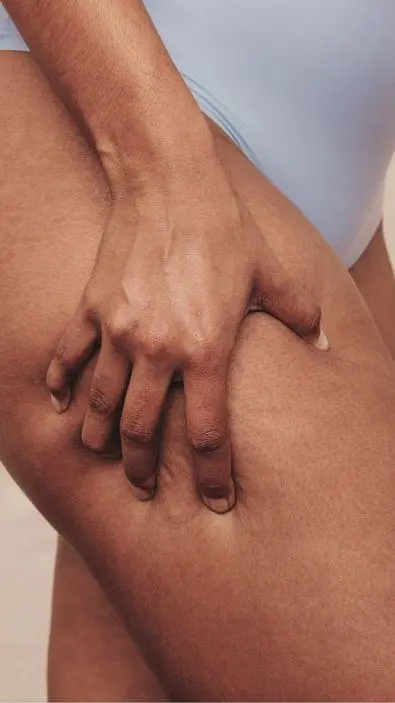
Thigh Lift Berlin
A thigh lift is a procedure that greatly influences the overall silhouette of the patient. While an excess belly, flabby upper arms or even sagging buttocks While an excess belly, flabby upper arms or even sagging buttocks can be concealed by the right clothing, the situation is different for thighs. These problems are often found to be resulting from an excess of skin and fatty tissue. Especially after massive weight loss or in the case of significant weight fluctuations, injuries to the skin and excess tissue can occur here due to the special nature of the skin. A thigh lift is often the last sensible measure to treat these problems.
Thigh Lift: The facts
Length of stay in the clinic
Anesthesia
Follow-up treatment
Resumption of social activities
Pains
Durability
Cost
When is a Thigh lift useful?
- For patients with hanging skin on the upper arms (wave arms)
- For patients who have lost a lot of weight in a short time, especially in the leg area, and then want to get rid of skin flaps and the last fatty tissue on the thighs
- For patients who have previously had liposuction, for example to remove so-called saddlebags

General Information about Thigh Lift with Prof. Dr. Sinis
During a thigh lift with the spindle-shaped incision, the soft tissues on the inside of the thigh, especially on the upper pole, can be removed and the thigh can be tightened. The great advantage of this method is the low scarring resulting from the spindle shape. This form of thigh lift results in a scar that runs across the thigh on the inside near the pubic region. The inner side of the thighs can also be tightened in this way, although not all thigh lifts can be carried out this way. A natural limit of this procedure is found with very voluminous thighs that offer so much excess skin and soft tissue that the lower parts of the thigh are not affected by the thigh lift.
The anatomy of the thigh also leaves many possibilities for complications and poor results in thigh lift procedures if the surgeon does not observe basic principles. Basically, we operate every thigh lift under magnifying glasses and in compliance with microsurgical principles. Particularly on the inside of the thighs, the thigh lift should be performed with appropriate care, so that lymphatic and blood vessels are preserved and protected. This ensures the safe removal of lymphs and blood even after the operation. A broad and, above all, microsurgical training also means safety and a high quality of results for your upcoming operation.
During a thigh lift, the excess fatty tissue and sagging skin are first marked and precisely measured. Then the marked areas are surgically removed. If possible, the incisions are made less visible so that the scars usually remain inconspicuous. In addition, targeted liposuction of adjacent areas can be performed, which further beautifies the body contour.
Experiences and procedure of the thigh lift in the Sinis Klinik Berlin
There are two different lift procedures for thigh lifts — a “small” lift, where the incision is between the groin and the ischium, and a “big” lift, where the incision is made vertically from the groin down to the inside of the knee.
The areas with excess fatty tissue and sagging skin are marked and measured. The thigh lift surgery is then prepared by disinfecting the relevant areas and inducing anesthesia. The use of vasoactive solutions minimizes bleeding while the skin is incised according to the pre-established procedure. The marked areas are opened and the underlying fatty tissue and excess skin flaps are then surgically removed. In addition, liposuction can be performed if necessary. The opening is then closed, and the remaining skin is tightened when the edges of the wound are sewn up. To drain off the wound fluid, drainage is applied for the first few days and then the bandage is applied.
Both before and after the procedure, your own behavior makes a significant contribution to reducing complications to a minimum and promoting wound healing. First of all, you should exhaust all possible weight loss measures before a thigh lift surgery. The result of the operation will be better the closer you are to your desired weight. In addition, any skin inflammation must be pre-treated by your dermatologist. About two weeks before the planned thigh lift, it is advisable to avoid smoking and alcohol as much as possible. The same applies to medicines, painkillers, vaccinations, sleeping pills or dietary supplements such as grape seed flour, which can have a blood-thinning effect. It would also be helpful if you start using contrast showers and continue them after the operation as soon as you are allowed to shower. This will promote wound healing, as your body and thus the wound area will be better supplied with blood. On the day of the thigh lift surgery, wash yourself thoroughly and do not use body lotions afterwards. You should also remember that you must be sober when you come to the clinic. The operating surgeon and the anesthesiologist will answer your last questions before the operation.
Immediately after thigh lift surgery, you may be required to take painkillers, which will give you the rest you need immediately after the procedure. Measures are also taken against embolism and blood clots - for example, thrombosis stockings can be put on. Also, be prepared to wear light compression with support tights for four to six weeks. This is extremely important because it promotes wound healing on the one hand and allows the scar to heal unobtrusively on the other. After about two weeks, the wound will have healed sufficiently for the stitches to be removed if necessary. However, it takes several weeks for the final healing to take place. At first you should only move carefully, avoiding excessive or jerky movements as the seams can be stretched. After about three weeks you will be more or less able to work again. And after about five weeks you can slowly start doing sports again.
During the entire healing process you will be looked after by us until the end result. We will arrange several check-ups for you, which you should definitely attend. These are important for your safety on the one hand and for a good aesthetic end result on the other.
Costs Thigh Lift Berlin
The costs of the initial consultation always depend on the type and extent of the treatment. In principle, the scale of fees for doctors applies to the consultation hours. Thereafter, patients pay 90 € for the initial consultation with anamnesis, collection of previous findings, physical examination and preparation of a therapy and cost plan. This fee is payable once and will not be credited towards further treatment. Additional appointments and post-operative care are included in the total price of the operation and do not have to be paid separately. This is the only way to ensure a high-quality treatment with sufficient treatment time, during which we can respond to you and your specific needs. In order to ensure the success of the treatment, we have to carry out the consultation with sufficient time and care.
Consultation
Open continuously from Tuesday 08.00 to Saturday 14.00
Open continuously from Tuesday 08.00 to Saturday 14.00

Thigh lift FAQs
-
A thigh lift involves tightening and removing the excess tissue on the inside of the thighs. During the thigh lift, the soft tissues are moved inwards and upwards to fix them at the highest point (at the edge of the pelvis) (so-called pexia of the thighs). This means the tightening of the thighs can permanently counteract the effects of gravity to prevent the skin and soft tissues from wearing out again in the long term. Basically, two different procedures can be distinguished from each other, both of which have their justification and areas of application. On method means, the incision can be made during the thigh lift in such a way that the result is a spindle-shaped figure far up on the inner side of the thighs. This spindle-shaped form can be used to move the soft tissues of the thigh inwards and upwards in such a way that the end result is a fine scar on the inside of the thigh, which is just below the pubic area and thus remains largely inconspicuous. Alternatively, this incision can be extended during the thigh lift so that the incision runs down the inside of the thighs to the knee. This results in a thigh lift with a t-shaped scar on the inside of the thighs.
-
A t-shaped cut in the direction of the knee makes sense if the thigh lift is not restricted to the upper part of the thigh. Then, following the spindle-shaped incision, a T-shaped incision can be made. This means the middle and especially the lower third of the thigh can also be changed by the thigh lift. The t-shaped incision is therefore particularly suitable for a thigh lift after massive weight loss, where the excess soft tissue and skin is so clearly manifested that a lift with a single transverse scar close to the pubic area is not sufficient. The choice of the right procedure is extremely important for the shape and thus the result of the thigh lift. As a rule, problems do not arise from longer scars but from unshapely and poorly tightened thighs. Therefore, if the findings are appropriate, the choice should be made for the T-shaped incision, so that no compromises have to be made in the shape and result of the thigh lift.
-
Similar to other forms of lifting operations (abdominoplasty, upper arm lift, etc.), it can be useful to combine the thigh lift with liposuction. The advantage is that the thigh lift can be sutured more easily and without tension after the subcutaneous fat mantle has been treated with liposuction. In addition, special deposits and fat accumulations, which have so far proved resistant to diets and sport, can be identified and marked before the thigh lift. This can also significantly improve the overall result of the thigh lift and bring out the thigh’s contour and silhouette harmoniously.
-
The traditional thigh lift surgery is of course only one of several ways to tighten the thighs. A thigh lift can also be performed completely without incisions, non-invasively and gently: Methods such as tightening with the help of thread lifting, laser skin resurfacing, laser lipolysis or tightening with liposuction offer such a possibility.
-
A thigh lift surgery in itself is unproblematic and for the most part does not involve any complications. However, as with any other operation, risks cannot be completely excluded. In order to reduce these to a minimum, some details should be clarified before the thigh lift. For example, you must inform us of any allergies to medications or blood clotting disorders. In addition, you must be treated with special care if you are susceptible to certain diseases of the veins and vessels or thromboses or embolisms. In addition, primary complications such as secondary bleeding or wound infections can sometimes occur. However, these types of complications can be avoided to a large extent by taking antibiotics and strictly adhering to hygiene measures. The most common complications of a thigh lift include bruising, feelings of tension, swelling and pain on movement, which, however, subside after a short time if the affected area is rested and cooled.
Basically, you can save yourself from most complications by choosing the right experienced and highly qualified surgeon.
Testimonials
After a long search I finally found the surgeon I trust! I have a complicated story about Prof. Dr. medical Sinis come. He encouraged me, but was honest with me at the same time.

